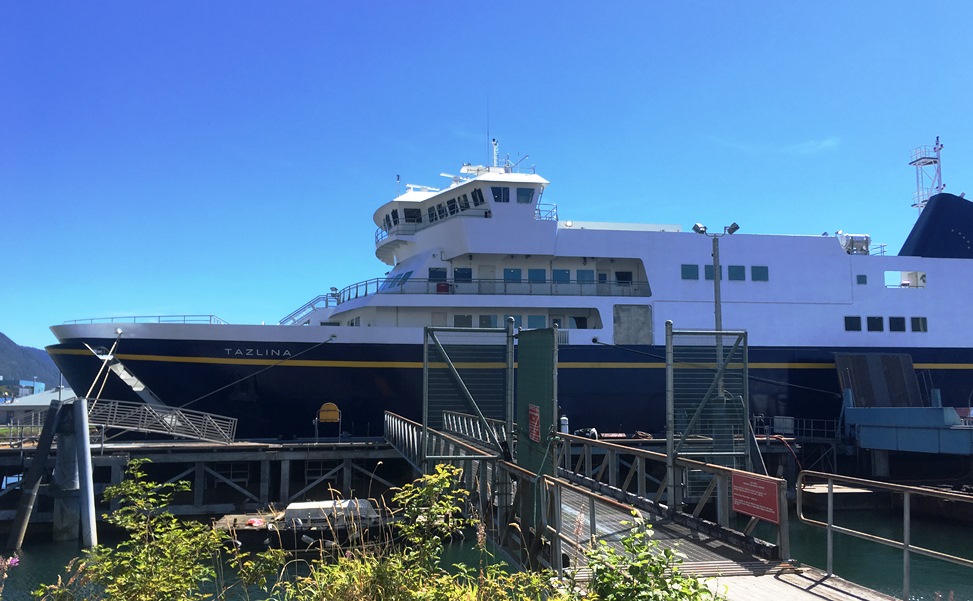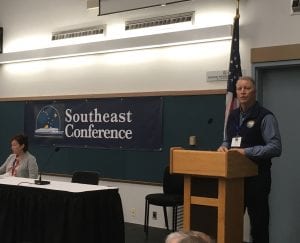
The Alaska Class Ferry Tazlina is at the Vigor Alaska Ketchikan shipyard in mid-August. (KRBD file photo by Leila Kheiry)
Alaska Marine Highway System officials hope to move forward with a plan to add crew quarters to its two newest ferries, the just-completed Tazlina and the Hubbard, which is under construction at Ketchikan’s Vigor Alaska shipyard.
The proposal was announced by Department of Transportation Commissioner Marc Luiken during his presentation Thursday morning at the Southeast Conference annual fall meeting at Ketchikan’s Ted Ferry Civic Center.
From the start of the Alaska Class Ferry process, many people thought the two new vessels should have crew quarters. Without them, the ferries are limited to voyages of 12 hours or less.
But to save construction costs, the state opted to go without crew quarters. Now, state officials are rethinking that decision.

Alaska Department of Transportation Commissioner Marc Luiken speaks during Southeast Conference’s annual fall meeting at Ketchikan’s Ted Ferry Civic Center. (KRBD photo by Leila Kheiry)
Luiken told the Southeast Conference crowd that eliminating gaps and providing reliable service are top problems that need to be solved by the state ferry system.
“By adding crew quarters, these ships become much more standardized with our current fleet, both the mainliners and our feeder ferries,” he said. “And they add flexibility and redundancy to the system to provide greater reliability and close gaps in the schedule that cannot be closed with the current fleet mix.”
AMHS Executive Director Shirley Marquardt says the two Alaska Class Ferries were designed a dozen or so years ago to run a specific, short route from the end of the Juneau Access Road. But that road extension was put on hold.
“So now we have two vessels coming into the system that will have to be tied up seven months out of the year,” she said. “We don’t really think that’s the best use of state funds to build these ferries.”
One, though, already is built. So, Marquardt says the proposal calls for the completed Tazlina to go into service as planned as a day boat in Lynn Canal in May. The Hubbard is in production, though, and she says state officials hope to get authorization to change the contract.
That authorization would have to come from the Legislative Budget and Audit Committee. Marquardt says the funds already are in the ferry system budget for vessel maintenance and replacement.
If the proposal is approved and everything moves forward, she says, Lynn Canal could have year-round service starting next year.
“The end of next summer early fall, when we would be losing the ACF ability to operate in Lynn Canal, now we don’t have to stop,” she said.
And, she says, with crew quarters the ferries would be able to serve elsewhere as needed.
Adding quarters to the Tazlina would happen later, Marquardt says, and a funding source for that work has not been identified.
“If it’s state dollars, it could be sole-sourced and stay in Ketchikan in Vigor and have the same work done,” she said. “They think it will take eight to nine months.”
If federal funding is required, she says, it would have to go out for bid.
Doug Ward is a spokesman for Vigor Alaska’s Ketchikan shipyard. He says it is potentially good news for the Ketchikan shipyard, which announced big layoffs last month as work on the two ferries was winding down. But, Ward was not celebrating quite yet.
“Until we actually see a contract and see what the terms are, it’s really hard to respond to what that’s going to do to layoffs,” he said.
Some veterans of the ferry system say the state’s decision to scrap the day boat concept always seemed inevitable.
Jay Butler retired as chief engineer of the Kennicott in 2016. He told CoastAlaska’s Jacob Resneck that there had been debates among officers and crew of the difficulty of running day boats in Southeast because of the distance between ports.
“So it makes sense; it’s not going to be any cheaper now. It probably will be more expensive in the overall scheme of things than it would’ve been to design it as it was originally intended to be,” Butler said. “And that was to replace the aging vessels and not be specifically just a day boat.”
Robert Venables is executive director of Southeast Conference, sits on the Alaska Marine Transportation Advisory Board and is heading up Southeast Conference’s effort to come up with a management reform plan for the ferry system.
Venables wanted more details before giving an opinion about the state’s proposal to add crew quarters. But, he says he can see the potential benefit of quarters on at least one of the two new Alaska Class ferries.
“So that there is some flexibility and capacity to back up the fleet when it breaks down because right now we’re in that terrible spot of time where we have an aging fleet that’s continuing to break down with longer delays, more costly repairs and there’s nothing to back them up,” he said.
Marquardt says the proposed crew quarters would not affect passenger or vehicle capacity for the ferries. The quarters would go in an area that was off limits to passengers, anyway.
The Alaska Marine Highway Reform Steering Committee will discuss more details of this new proposal from the state during a morning work session on Friday, the third and final day of Southeast Conference.
Thanks to CoastAlaska’s Jacob Resneck for assistance with this report.





